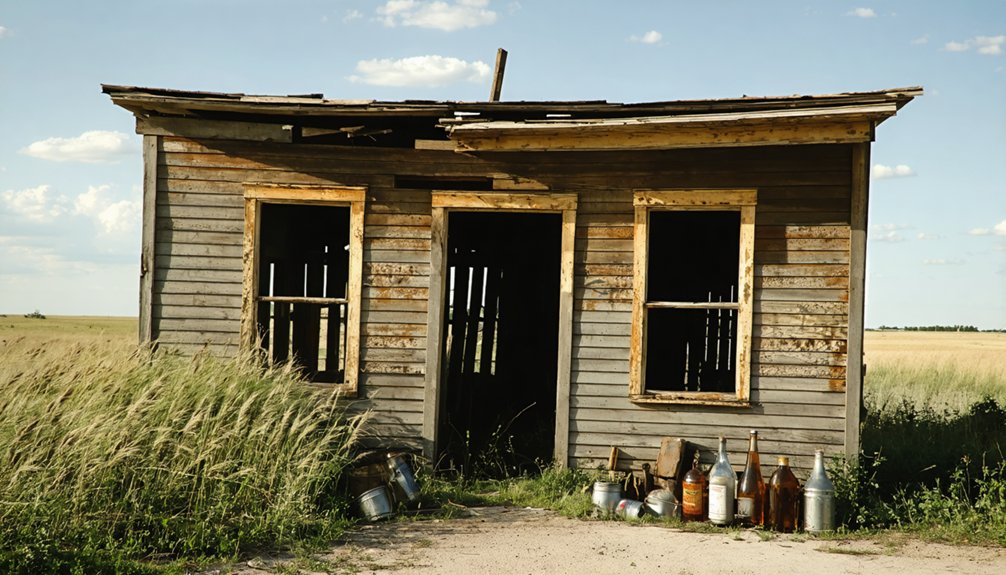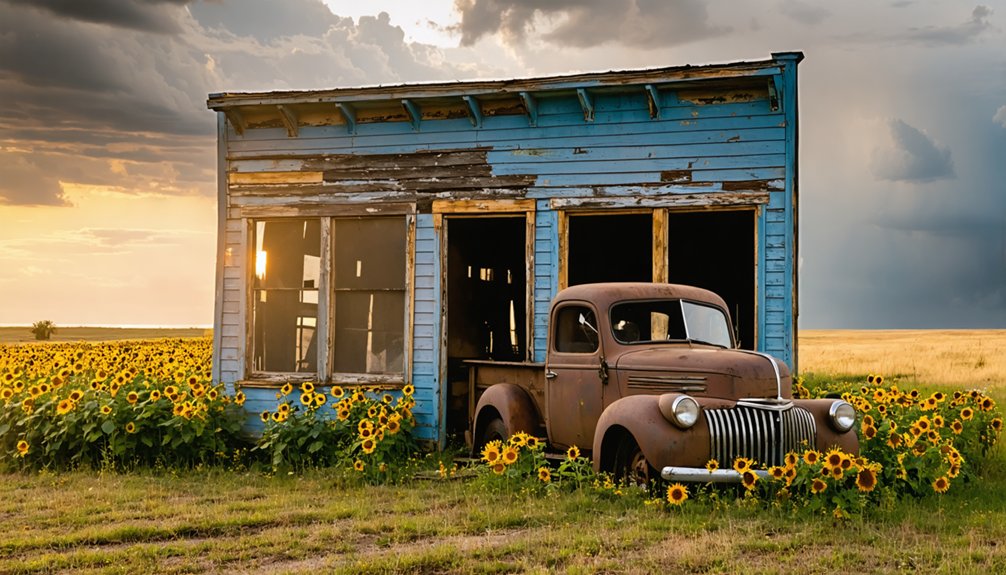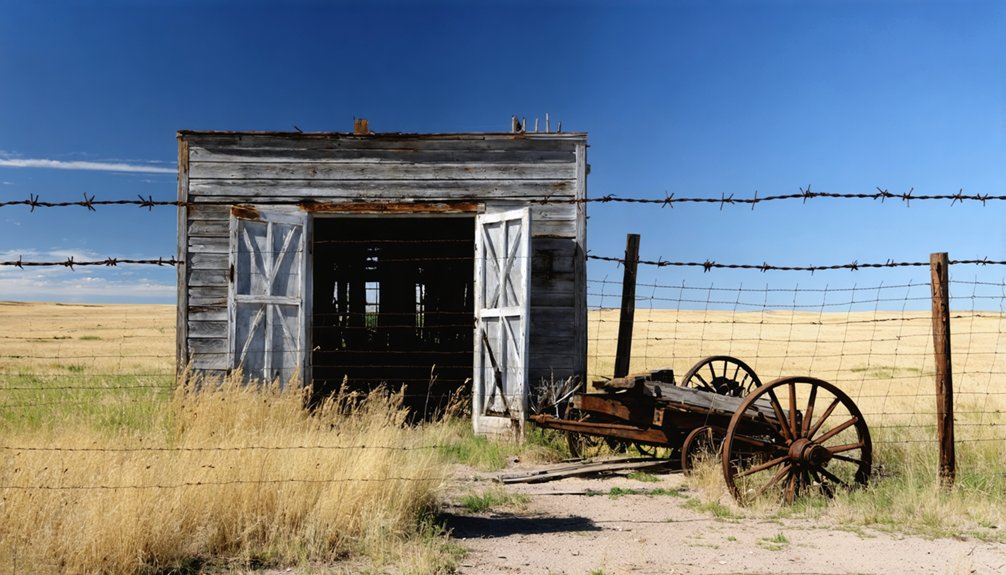You’ll find Gopher nestled at 6,650 feet in South Dakota’s Black Hills, where it emerged during the late 19th century gold rush. The settlement grew to nearly 100 residents, supporting essential mining infrastructure and diverse community life, from general stores to social halls. While the town experienced typical boom-and-bust cycles of mining communities, its preserved buildings and rich historical records offer fascinating glimpses into Black Hills pioneer life.
Key Takeaways
- Gopher emerged during the Black Hills gold rush in the late 19th century, reaching a peak population of nearly 100 residents.
- The town was built around a copper mine at 6,650 feet elevation and experienced typical mining boom-and-bust cycles.
- Historical structures include rustic wood and stone buildings, stamp mills, and assay offices from the gold rush era.
- Early settlers included European immigrants and Civil War veterans who relied on hunting, foraging, and community support.
- The site is now considered historically significant and is a candidate for the National Register of Historic Places.
The Rise and Fall of a Black Hills Community
When gold fever swept through the Black Hills in the late 19th century, the mining community of Gopher emerged as one of many hopeful settlements dotting the region’s rugged landscape.
You’ll find that Gopher’s cultural heritage began with ambitious prospectors who established essential infrastructure to support mining technology and growing families. At its peak, nearly 100 residents called this bustling town home. Like many of the six hundred ghost towns scattered throughout the Black Hills region, Gopher rose and fell with the tides of fortune. Much like the town of Mystic, Gopher became a candidate for the National Register due to its historical significance.
In its heyday, Gopher’s pioneering spirit drew hopeful miners who built a close-knit community of determined frontier families.
But like many Black Hills settlements, Gopher’s prosperity wouldn’t last. As mineral prices fluctuated and resources depleted in the early 20th century, the mines that once promised endless wealth began to close.
The town’s lifeblood – its mining operations and sawmills – gradually shut down, forcing residents to seek opportunities elsewhere. By mid-century, Gopher had transformed from a thriving community into another silent reflection of the region’s boom-and-bust legacy.
Life in Early Gopher Settlement
You’d find early Gopher settlers carving out their existence through grueling physical labor, with families hauling lumber across long distances to build their homes and breaking tough prairie sod to establish farmland. The Land Company speculators played a key role in establishing the early settlement patterns of towns like Gopher.
The local general store served as both a vital supply hub and gathering place for settlers to exchange news and goods, reflecting the broader economic patterns of early Dakota settlements. Social bonds formed quickly among the diverse mix of European immigrants and Civil War veterans as they relied on each other for harvesting, construction projects, and general survival in the harsh Dakota environment.
Despite the isolation and challenges of frontier life, you’d see cultural traditions maintained through community gatherings and church services, while practical activities like pest control and hunting doubled as both necessary work and social recreation.
Early Pioneer Living Conditions
Life for Gopher’s earliest settlers revolved around basic survival amid the harsh Dakota prairie conditions. You’d have found pioneer hardships at every turn – from constructing makeshift shelters near the James River’s edge to hauling essential supplies from distant railheads.
Your first home would’ve been a simple log cabin or sod house, built with neighbors’ help using materials you’d gathered from nearby riverbanks. The extreme temperatures made both winters and summers particularly challenging for settlers.
Your survival strategies centered on securing water, food, and shelter. You’d have hunted deer and antelope, foraged for wild berries, and maintained a small garden. Without refrigeration, you’d preserve food through drying and smoking. The Homestead Act of 1863 allowed settlers to claim their land by farming and improving it.
Daily life meant constant physical labor with basic tools – breaking soil, repairing equipment, and tending to livestock, all while battling isolation and harsh weather that tested your resilience.
Mining Community Social Life
Despite the grueling demands of mining work, social bonds in Gopher flourished through carefully structured community gatherings and mutual support networks.
You’d find a clear social hierarchy led by mining officials and business owners, yet the town’s diverse mix of immigrants, prospectors, and families created a vibrant communal fabric. The discovery of gold in French Creek had initially drawn many of these settlers to the Black Hills region. When the Homestake Mining Company formed in 1877, it further shaped the social structure of mining communities throughout the area.
Life revolved around shared activities – from informal baseball games and horse races to traveling shows and harvest festivals.
You’d witness women gathering at water sources to exchange news while doing laundry, and miners unwinding at local taverns after long shifts.
Churches and social halls became essential spaces where you could attend both religious services and community celebrations.
Even in hardship, residents maintained strong bonds through mutual aid societies, mining unions, and informal support networks that helped everyone survive the town’s economic uncertainties.
Mining Operations and Economic Impact
The mining operations in Gopher emerged as part of South Dakota’s rich mineral extraction history, centered around a copper mine situated at 6,650 feet elevation in Pennington County.
You’ll find that mining technology advancements transformed the industry here, as operations evolved from basic hand tools to sophisticated machinery and processes. Safety measures like protective equipment became standard practice to ensure low accident rates. The implementation of compressed air locomotives in nearby mines revolutionized underground transportation methods. The region’s mining sector, anchored by giants like the Homestake Mine, drove substantial economic development throughout Pennington County.
You’ll notice economic fluctuations defined the area’s growth, with mining companies investing heavily in infrastructure while creating thousands of jobs. The industry’s boom-and-bust cycles shaped local communities, though modern environmental regulations since the 1970s have changed how mines operate.
Today, you can see the legacy of these operations in the carefully managed environmental programs and reclamation efforts throughout the Black Hills region.
Daily Routines of Pioneer Residents
Your dawn-to-dusk routine as a Gopher settler would begin with essential livestock care, as you’d coordinate with family members to herd cattle using picket ropes across the open prairie.
You’d allocate significant morning hours to pest control, particularly setting snares for destructive gophers threatening your crops, while simultaneously tending to your vegetable gardens and agricultural plots.
Morning Chores and Tasks
Pioneer residents of Gopher began their daily routines well before dawn, when darkness still blanketed South Dakota’s rugged landscape. You’d start by igniting the wood stove for warmth and cooking, while preparing to milk cows and tend to morning livestock.
Each moment counted as you’d gather eggs, feed the animals, and check their health – all critical tasks for survival in this frontier town. Your practical clothing would protect you from the harsh climate as you’d repair fences, clean stables, and maintain essential tools.
You’d coordinate with neighbors, sharing resources and news while preparing for the day’s mining or farming work. The well-orchestrated morning tasks required careful planning, especially during severe weather, ensuring your family and community could thrive in this challenging environment.
Work-Life Balance Practices
Following the dawn routines, miners and their families balanced exhaustive workdays with crucial domestic duties in Gopher’s challenging environment.
You’d find miners working long shifts from early morning until late afternoon, while family members managed households and supported mining operations.
During winter months, you’d need to adjust your work-life balance as harsh conditions limited mining activity.
After mining shifts, you’d tackle domestic chores like cooking, mending clothes, and maintaining your home.
Community resilience played a crucial role in managing workloads, as you’d join neighbors for mutual aid events and share resources.
When economic conditions fluctuated, you’d adapt by diversifying into farming or crafts.
Sunday provided your main respite, offering time for church services, social gatherings, and strengthening community bonds.
Historic Buildings and Landmarks

As mining operations flourished across South Dakota’s Black Hills in the late 1800s, Gopher’s landscape became dotted with rustic wood and stone structures characteristic of gold rush boomtowns.
You’ll find typical architectural features of the era, including remnants of stamp mills and assay offices that once processed precious metals from nearby mines.
Like many Black Hills ghost towns, Gopher’s historic preservation efforts reveal a mix of intact and deteriorating structures.
You can explore abandoned commercial buildings, including what remains of the town’s shops and civic structures.
While some buildings stand roofless and others have crumbled to their foundations, these ruins provide glimpses into the town’s mining heritage.
Former residences and business storefronts line the streets, offering silent testimony to the bustling community that once called Gopher home.
Natural Resources and Geography
Located in the rugged Black Hills region of South Dakota, Gopher rests among rolling hills, exposed granite outcrops, and mixed prairie-pine ecosystems.
You’ll find this ghost town‘s natural resources were typical of Black Hills settlements, with gold, silver, lead, and carbonate ores drawing prospectors in the late 1800s.
The geographic features surrounding Gopher likely influenced its placement, as most Black Hills ghost towns were established along wagon roads and near canyon mouths or creek beds.
Fresh water sources were essential for both mining operations and daily life, though seasonal fluctuations and drought posed constant challenges.
The landscape’s abundant Ponderosa pines provided timber for construction, while native grasses served as forage.
However, intensive mining, logging, and grazing eventually stripped much of the original vegetation.
Preserving Gopher’s Legacy Today

While many ghost towns fade into obscurity, dedicated preservation efforts keep Gopher’s history alive through a network of organizations and passionate individuals.
The South Dakota State Historical Society, working alongside local preservation groups, maintains essential records and coordinates community engagement initiatives that help protect the site’s remaining structures and artifacts.
You’ll find various preservation initiatives in action, from carefully managed walking tours to detailed documentation efforts.
These activities include collecting oral histories from descendants, digitizing historical records, and implementing protective measures against vandalism.
Local historical societies organize educational events that connect you directly with Gopher’s past, while preservation commissions guarantee that any restoration work maintains historical authenticity.
Through these combined efforts, you’re able to experience and learn from this important piece of South Dakota’s heritage.
Notable Events and Local Stories
Throughout its brief but eventful history, Gopher witnessed numerous incidents that shaped both its rise and eventual decline during the Black Hills mining boom.
Like many frontier settlements, local folklore speaks of sudden fortunes made and lost in the mines, while ghost stories tell of transient souls who passed through during the town’s heyday.
Tales of riches gained and squandered echo through Gopher’s ghostly remains, alongside whispers of wandering spirits from its golden age.
You’ll find tales of a woman’s remains being hastily transported back to Deadwood, reflecting the harsh realities of pioneer life.
The town’s dramatic transformation from a bustling community with saloons, hotels, and rail connections to an abandoned settlement has inspired photographers and history enthusiasts.
Nearby grave markers and plaques memorialize those who succumbed to influenza outbreaks, adding poignant human stories to Gopher’s rich historical tapestry.
Frequently Asked Questions
How Did the Town Get Its Unusual Name “Gopher”?
You’ll find the town’s naming origins aren’t definitively recorded, but historical evidence suggests it likely came from abundant gopher populations in the area during its frontier settlement period.
Are There Any Surviving Photographs of Gopher During Its Peak Years?
You won’t find surviving photographs of Gopher’s peak years in public archives. While other Black Hills ghost town photographs exist, historical records indicate Gopher’s visual history hasn’t been preserved in accessible collections.
What Happened to the Cemetery and Burial Records From Gopher?
Like many forgotten prairie tales, you’ll find Gopher’s burial records scattered across WPA grave registrations from 1940-41, while the physical cemetery likely vanished as nature reclaimed the abandoned town’s grounds.
Can Visitors Legally Explore and Metal Detect in Gopher Today?
You’ll need landowner permission before exploring or metal detecting, as visitor safety and regulations aren’t clearly established. Without knowing the land’s legal status, assume it’s private property requiring explicit consent.
Were There Any Notable Crimes or Lawless Incidents in Gopher?
You won’t find documented historical crimes or notable lawless incidents specific to Gopher. Like other small mining settlements, it likely had minimal law enforcement but no recorded major criminal activity.
References
- https://www.sdpb.org/rural-life-and-history/2023-08-21/some-black-hills-ghost-towns-and-their-origins
- https://www.sdhspress.com/journal/south-dakota-history-2-2/some-black-hills-ghost-towns-and-their-origins/vol-02-no-2-some-black-hills-ghost-towns-and-their-origins.pdf
- https://www.powderhouselodge.com/black-hills-attractions/fun-attractions/ghost-towns-of-western-south-dakota/
- https://news.icpc.global/2017/04/22/gold-dreams-became-a-ghost-town-in-south-dakota/
- https://www.youtube.com/watch?v=_0WNYsFLSLA
- https://www.blackhillsbadlands.com/blog/post/old-west-legends-mines-ghost-towns-route-reimagined/
- https://www.geotab.com/ghost-towns/
- https://en.wikipedia.org/wiki/List_of_ghost_towns_in_South_Dakota
- https://www.youtube.com/watch?v=NUjJ2DaEv3Y
- https://blackhillsvisitor.com/learn/spokane/



